Do you produce an employee benefits newsletter? If not, why not? We tell you why they are important along with key tips on how to design them.

.png)
Strategy is an important component of internal communications. Ensure you’re communicating through the right channels at the right frequency with our Internal Communications Channel Audit worksheet.
Access NowHuman resources professionals understand the importance of employee benefits in attracting, retaining, and engaging top talent. After all, keeping employees informed and engaged is key to a happy and productive workforce.
The employee benefits newsletter is an underutilized tool that can improve employee engagement and retention. It can also be a powerful internal communications tool for sharing the full range of HR benefits to your workforce.
Metlife, one of the largest global providers of insurance, annuities, and employee benefit programs, has about 90 million customers in over 60 countries. Their research speaks volumes. They share valuable statistics in New Year, New Benefits Experience: Lessons from Gen Z on Engaging a Multi-Generational Workforce.
Published in January 2024, it states that employees experience unique challenges they want employers to address. More than half (54%) want personalized benefit recommendations, and 65% want employers to communicate with them about their benefits throughout the year, not just during enrollment.
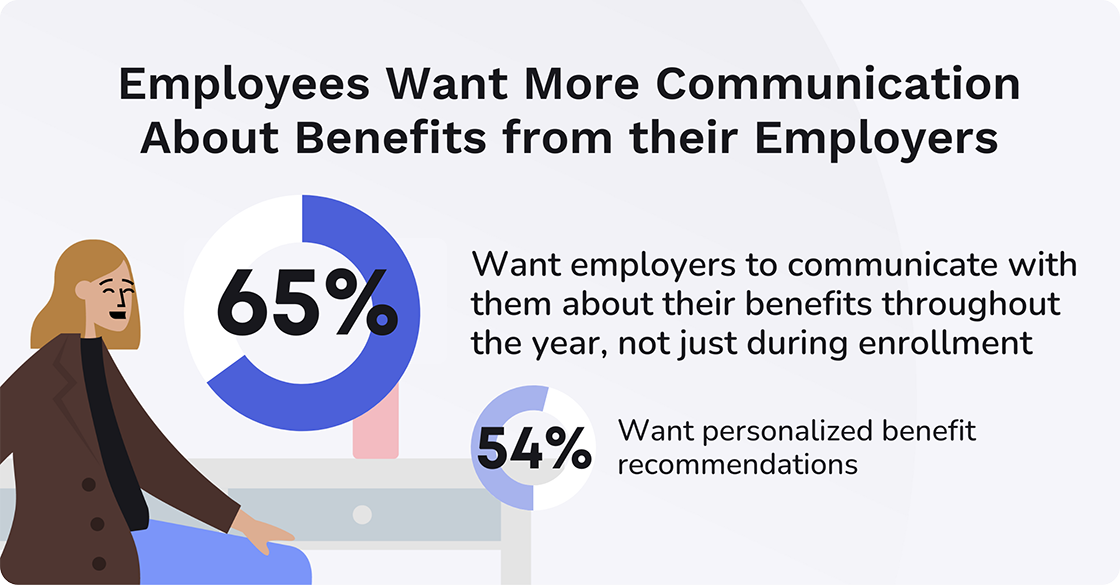
But the real focus is on Generation Z — employees born between the mid-1990s to the early 2010s. This generation is growing up in a world where technology, social media, and the internet are an integral part of daily life. Unsurprisingly, the prediction is that the number of Gen Z in the workforce globally will exceed Baby Boomers by early 2024. These are, of course, people who were born between about 1946 and 1964, so it makes perfect sense.
The importance of this is that half of current Gen Z employees don’t think internal communications about benefits are relevant. Even more (63%), want employers to offer more personalized recommendations. This group of employees is also the least likely to find that their benefits meet their evolving needs.
Clearly, it’s complicated, which is why it’s so important for organizations to provide clear communication regarding all benefits offered.
Guidelines for newsletters that will maximize employee commitment
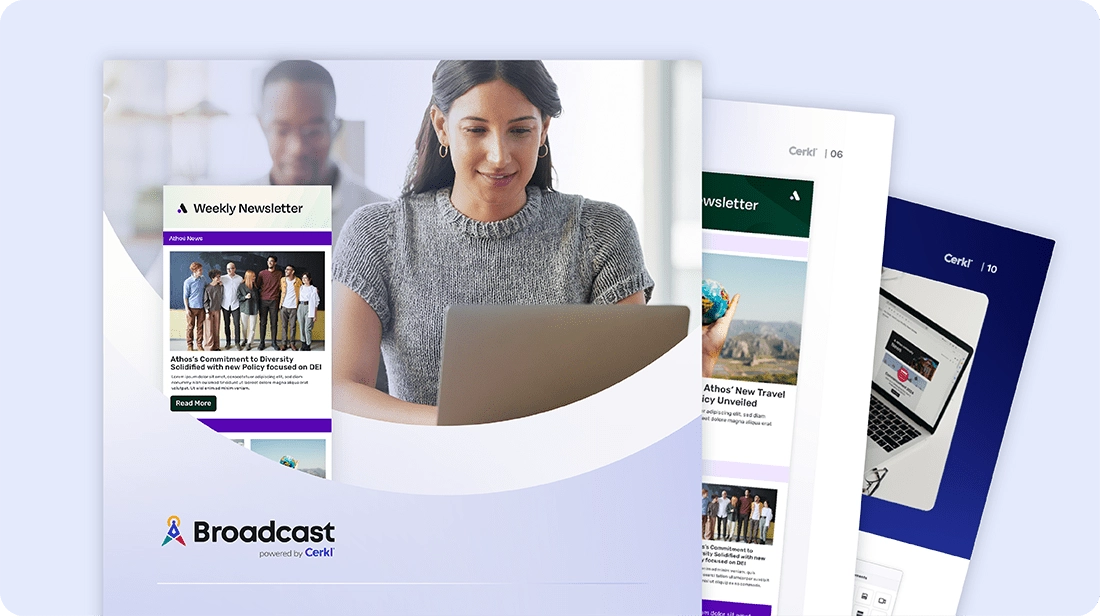
An employee benefits newsletter is a regular (usually monthly or quarterly) form of communication that focuses on explaining and promoting the benefits offered by your company. It can be delivered electronically or in print, depending on your company's culture and preferences. But the digital option is the most common nowadays.
The primary purpose of an employee benefits newsletter is to educate, engage, and empower employees to make the most of their benefits, leading to increased understanding, appreciation, and utilization of these valuable perks.
Typical topics include:
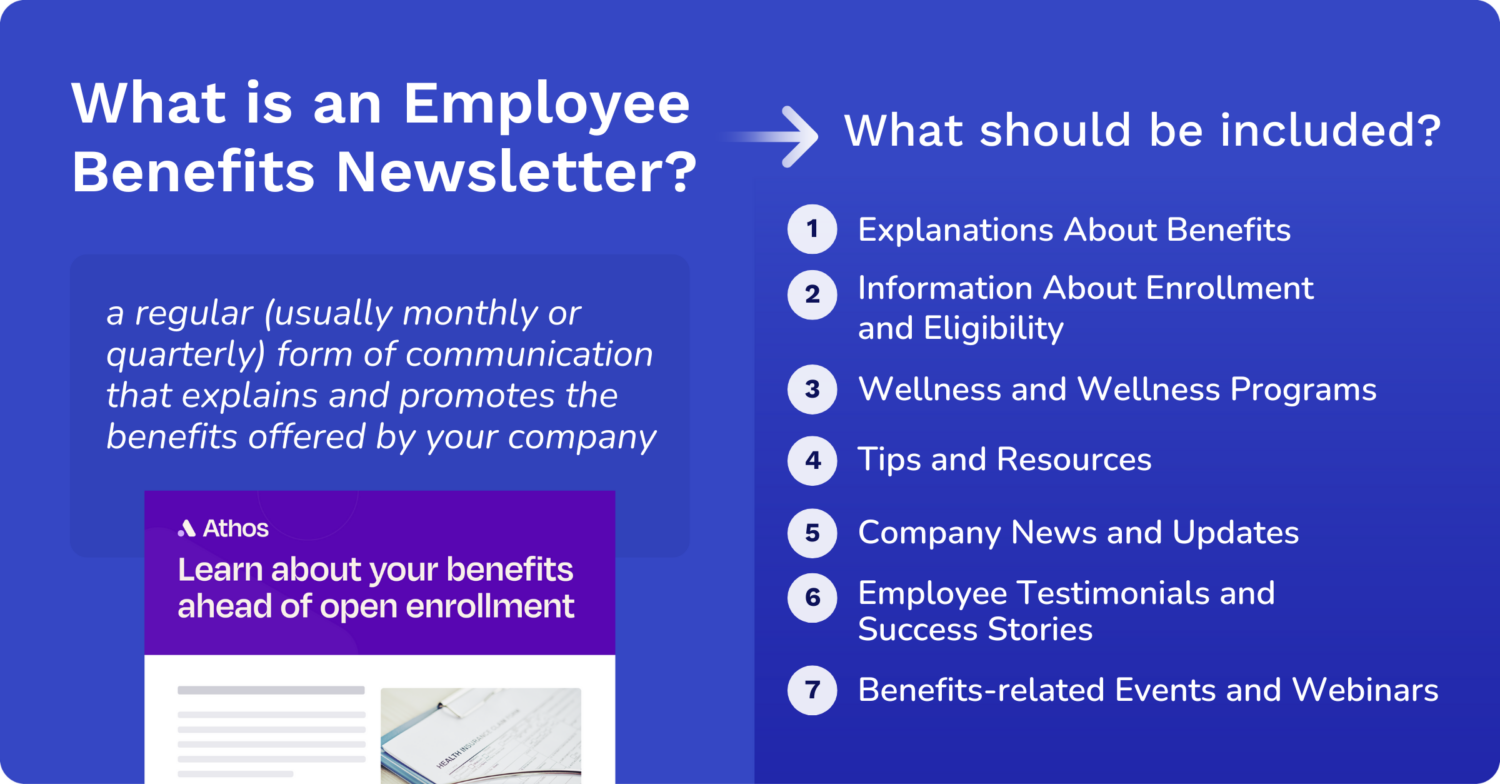
There are several reasons why employee benefits newsletters are important. These range from increasing employee understanding and appreciation of their benefits to encouraging employees to take advantage of available benefits. Ultimately, employee benefits newsletters are a valuable internal communications tool for companies to improve employee understanding and appreciation of their benefits package.
Guidelines for newsletters that will maximize employee commitment

Many employees don't fully grasp the value of the benefits available to them. An internal newsletter can explain these benefits in clear, concise language. It can also highlight features that employees might not be aware of, like wellness programs or financial planning resources.
On an even more basic level, employee newsletters can also explain eligibility requirements and enrollment processes. And when new benefit offerings are available, they can promote these as well.
By explaining the value proposition of different benefits, a newsletter can encourage employees to take advantage of them. This can lead to a healthier, happier, and more financially secure workforce.
The Maven’s State of Women’s & Family Health Benefits 2024 report tells how “fertility, maternal health, and Gen Z are transforming benefits decisions.”
“The world is changing — and benefits need to change with it.”
Maven Clinic
One critical issue that they highlight is that rising costs are now unsustainable for both employers and employees. Two quotable stats are:
Ultimately, says Maven, “Employers must build trust with their workforce to ensure healthcare and benefits utilization, driving improved outcomes and ROI.”
A well-designed employee benefits newsletter can answer many of the common questions employees have about their benefits. This frees up HR staff to focus on more strategic initiatives. It can also increase HR benefits by providing employees with relevant and timely information about benefits. This can lead to increased employee satisfaction and retention, which can have a positive impact on the organization's bottom line.
Newsletters that go beyond just listing benefits and include success stories, tips, and resources can make employees feel more valued and connected to the company.

Here are some basic tips to help you the most of a benefits newsletter:
Looking for inspiration? Here are two quarterly employee benefits newsletter examples, each offering a very different approach.
The University of Idaho's Benefits Newsletter provides clear explanations of benefits and helpful tips for maximizing their value. Designed in black and white, it has a simple layout with running text and lots of bullet points.
Cook County's Employee Benefits Newsletter goes beyond just benefits, including articles on financial literacy and family-friendly activities. Designed using the Cook County corporate green and blue colors, this example is more in the style of a printed newsletter. There are 11 numbered pages, each with its own topic of interest.
An effective employee benefits newsletter isn't just a medium or channel to inform employees. It's about creating an internal communications tool that drives engagement and maximizes the value of the benefits program an organization offers.
These are the metrics you should track to measure the impact of your newsletter.
These basic email metrics tell you how many employees are opening an employee benefits newsletter and clicking on the links within it. A high newsletter open rate is desirable, and clicks indicate deeper engagement with the content.
Track how many employees visit specific benefits pages on your company website after clicking links in the newsletter. This shows their interest in specific benefits.
Compare enrollment rates for different benefits before and after featuring them in a newsletter. This can indicate if the newsletter effectively communicated the value of a particular benefit.
Monitor the volume of questions HR receives about benefits after a newsletter is sent. A decrease in inquiries could suggest a successful newsletter that clarifies confusing topics. On the other hand, they could indicate a lack of interest. This is why pulse surveys are so valuable for real-time employee feedback.
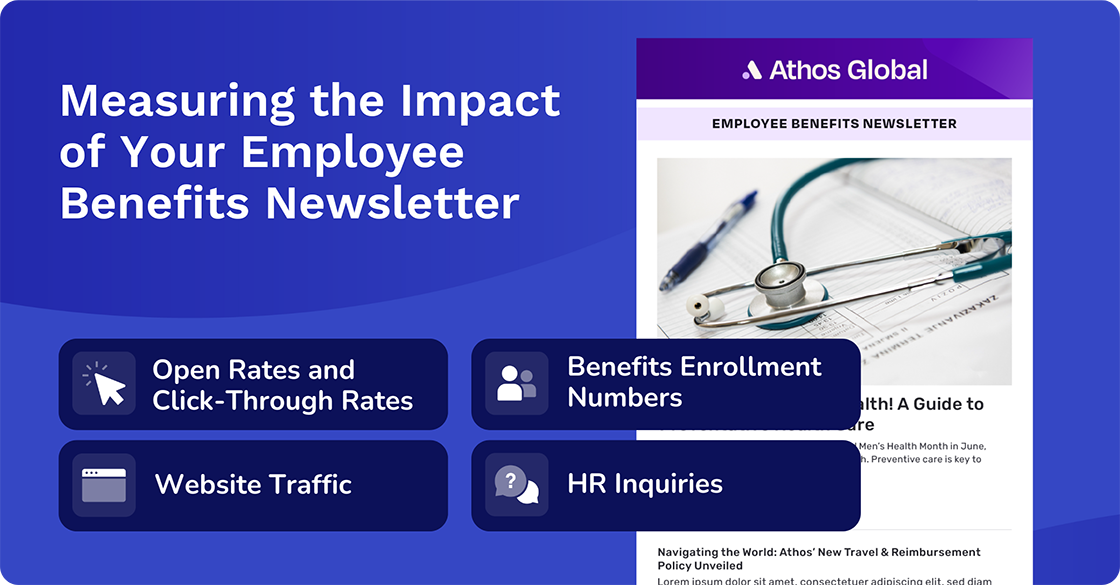
Crafting a compelling employee benefits newsletter takes time and effort. But with the right tools and strategies, you can automate some aspects of the process, freeing up valuable HR resources.
Cerkl Broadcast is the ideal platform for keeping your employees informed about available HR benefits. It will enable you to simply benefit offerings and communicate new policies or strategies as well as any regulations that might have changed, affecting employee benefits. Audience Manager will enable you to segment your internal communications to ensure relevance. You can also use Broadcast News Digest to focus on employee benefits through its dynamic newsletters.
This post provides you with key tips and invaluable information to help you design and produce an effective employee benefits newsletter. It also provides guidelines on how to automate it. But if you're looking for even more information about creating newsletters, you'll be interested in our publication, Employee Newsletters: A Comprehensive Guide for Internal Communicators. Whether you want to know about the value of newsletters as an internal communications tool or the best practices to follow when creating them, Employee Newsletters is for you. Furthermore, you can download it today absolutely free.
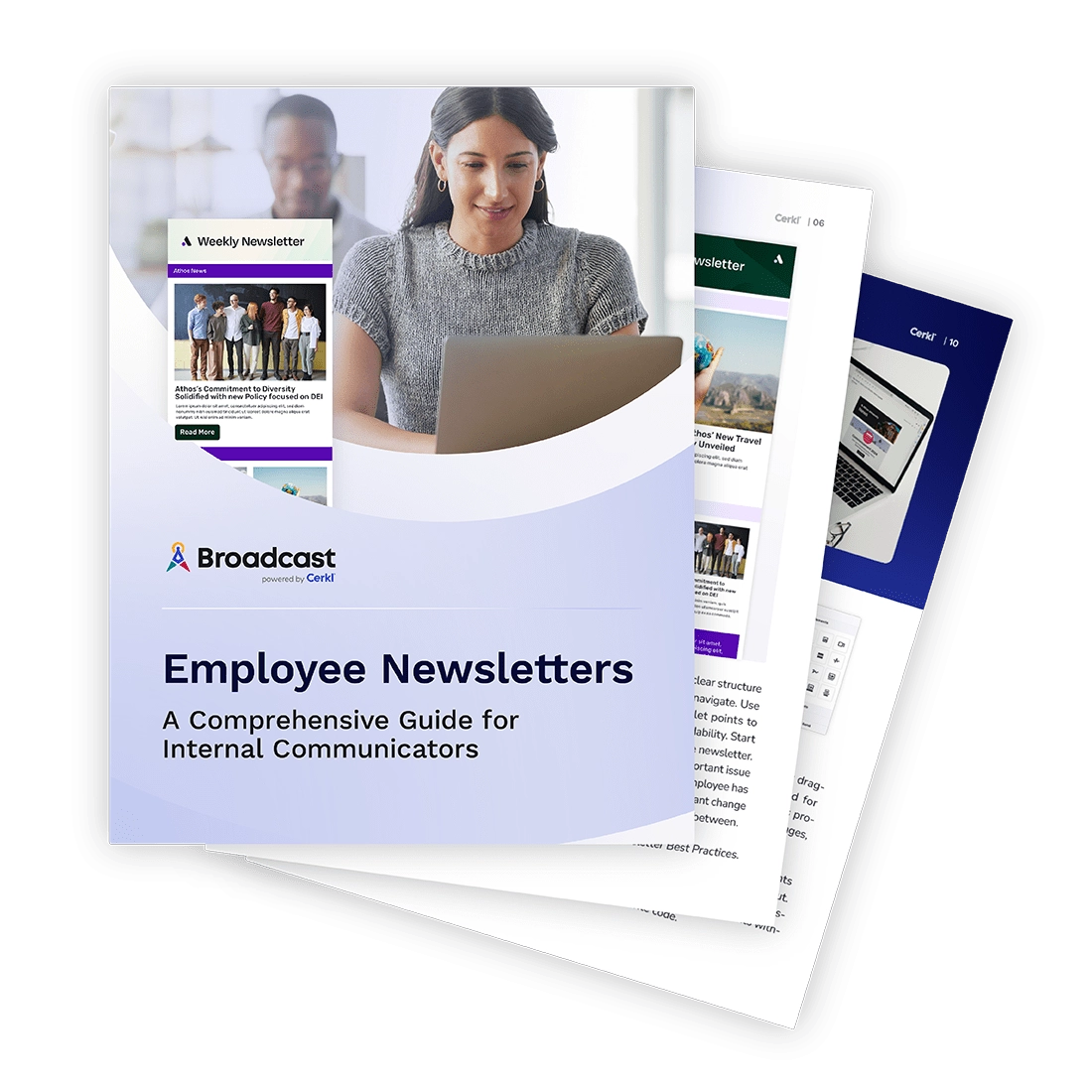
Guidelines for newsletters that will maximize employee commitment
How do I create an engaging employee newsletter? To create employee newsletters that are engaging, it’s important to focus on providing valuable and relevant content that resonates with your employees. This includes company news, employee spotlights, and benefits updates. Use a clear and concise writing style, incorporate visually appealing graphics and images, and make sure to include a clear call-to-action to encourage employee engagement and feedback.
What is the most important element of an internal newsletter? Relevance is probably the most important element of any internal newsletter. Whatever it focuses on, it should provide valuable and timely information that resonates with employees and addresses their interests and concerns. A relevant newsletter will keep employees engaged, motivated, and informed about the organization's goals, achievements, and initiatives.
What is a good opening sentence for a newsletter? A good opening sentence for a newsletter should grab attention, and be concise and relevant to the content that follows. Here are a couple of examples:
1. Get ready to save big on your health insurance premiums with our new benefits package!
2. Discover the latest wellness programs designed to support your mental and physical health.

Guidelines for newsletters that will maximize employee commitment